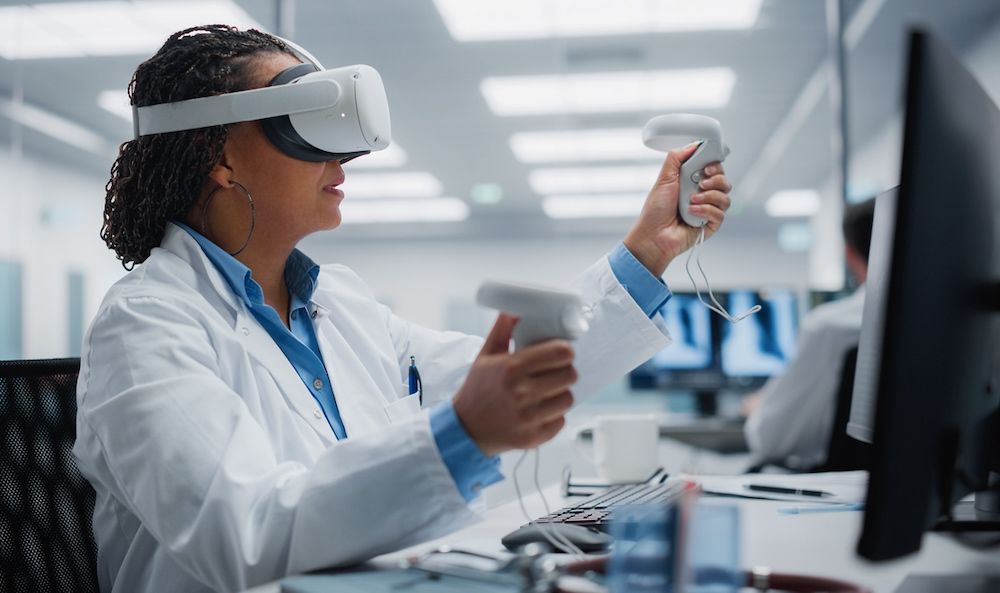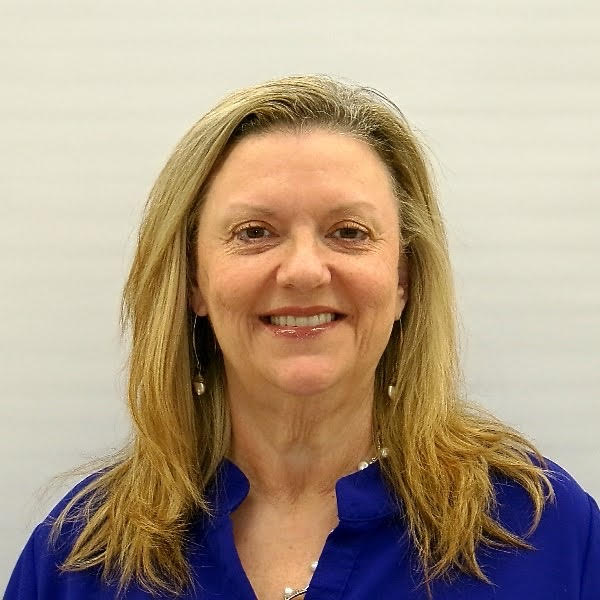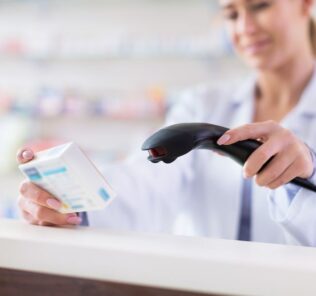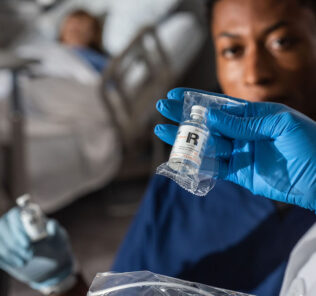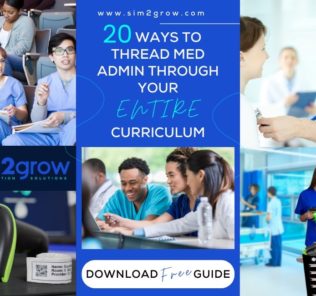Virtual Reality Simulation in Pharmacy
Virtual Reality in healthcare simulation has grown exponentially since Covid – 19 pandemic. Healthcare Simulation has been incorporated into the Doctor of Pharmacy curricula. According to the Healthcare Simulation Dictionary, Virtual Reality is the use of computer technology to create an interactive three-dimensional world in which the objects have a sense of spatial presence in an immersion effect. Virtual Reality is used in Healthcare Simulation environments to allow learners to experience visual stimuli delivered via computer graphics, as well as other sensory experiences. A large benefit of advancing Virtual Reality in healthcare technology is that Virtual Reality lets students learn how to perform a number of tasks and procedures involving the human body without ever having to practice on a live patient. This HealthySimulation.com article will explore the use of Virtual Reality in the Doctor of Pharmacy curricula.
Use of Simulation in the Doctor of Pharmacy Program
The Accreditation Council for Pharmacy Education (ACPE) is the national agency for the accreditation of professional degree programs in pharmacy and providers of continuing pharmacy education. The Accreditation Council for Pharmacy Education (ACPE) Accreditation Standards and Key Elements for the Professional Program in Pharmacy Leading to the Doctor of Pharmacy Degree has established guidelines to guide professional education of the doctorally-prepared pharmacy programs.
Sponsored Content:
The following ACPE Standards specifically mention simulation:
- Standard 11: Interprofessional Education (IPE) – 11.2 Interprofessional team education which states that some but not all of the IPE activities may be simulations.
- Standard 12: Pre-Advanced Pharmacy Practice Experience Curriculum – 12.7 Simulation for Introductory Pharmacy Practice Experience (IPPE) states that a maximum of 60 clock hours of the total 300 hours may be completed in simulated practice experiences. However, the simulation hours do not substitute for the 150 clock hours of required IPPE time in the community and practice settings.
- Standards 18: Faculty and Staff – Quantitative Factors – 18.1 Sufficient faculty members are required to effectively address programmatic needs, including teaching via didactic, simulation, and experiential learning.
- Standard 21: Physical Facilities and Educational Resources – 21.2 Physical facilities’ attributes state the physical facilities are adequate to meet the program’s needs, including access to educational simulation capabilities.
Research to Support Virtual Reality in Doctor of Pharmacy Curriculum
Yang et al. (2023) Pharmacy student’s perceptions, behaviours, and attitudes toward virtual reality simulation determined junior and senior pharmacy students positively perceived that VRS could help them with practical ability, autonomous learning, and theoretical knowledge. There was a significant positive correlation that was observed between mean perception score and mean attitude score, mean comparison, and mean behavior. This study revealed that pharmacy students who thought VRS was beneficial were more likely to embrace learning with VRS. This study provides some guidance for the need to establish interactive, immersive, and measurable VRS courses. When a good interaction between the faculty and students exists, technology improvement and blended programmatic assessment should be involved in challenges for implementing VRS courses.
Sponsored Content:
View the HealthySimulation.com LEARN CE/CME Platform Webinar Integrating Pharmacy Learners Into IPE Healthcare Simulation Events to learn more!
Granier et al. (2023) Use of simulation for education in hospital pharmaceutical technologies: a systematic review: Data summary Our search criteria resulted in 6248 articles, of which 24 were assessed for eligibility, and 13 were included in the qualitative synthesis. Simulation in hospital pharmaceutical technology education is used in three different ways: first, as a playful pedagogical tool, with error-based simulations (cleanrooms and preparation sheets with errors), or game-based simulations (escape games, role-plays, and board games); second, as an electronic tool with virtual reality (virtual cleanrooms and serious games), or augmented reality (3D glasses); finally, to evaluate chemical contamination (fluorescein and quinine tests) and microbiological contamination (media-fill tests) during compounding to periodically requalify pharmacy technicians. Further studies, including non-technical skills evaluations, are needed to confirm the usefulness of this innovative technique in training as efficiently as possible actual and future pharmacy professionals.
Korayem et al. (2022) Simulation-Based Education Implementation in Pharmacy Curriculum: A Review of the Current Status: Simulation-based education (SBE) has become crucial for developing students’ teamwork, decision-making, and communication skills. The Accreditation Council for Pharmacy Education (ACPE) has acknowledged the benefit of SBE in interprofessional education (IPE) and the introductory pharmacy practice experience (IPPE). This article provides evidence that SBE can be effective beyond IPE and IPPE. This narrative review provides evidence that SBE is an effective teaching method that could be utilized within the pharmacy curriculum. This article stresses the importance of the educator to determine the best modality and placement of integrating patient simulation within the pharmacy curriculum. Combining multiple simulation techniques may be the best way to achieve the desired student learning outcomes.
Use of Simulation in the Doctor of Physical Therapy Curriculum
The American Council of Academic Physical Therapy (ACAPT) reported results from two surveys on Simulation-Based Education in Physical Therapist Education: A Survey of Current Practice:
- 92% of programs reported some form of simulation used in their PT program
- 92% of programs reported access to a simulation center.
- The largest number of faculty primarily responsible for simulation coordination received training from their institution (48%) or were self‐taught (37%).
- 21% of faculty responsible for simulation reported having no training at all.
- 86% of the responding PT programs included at least three SBLEs during the course of their program.
- 69% of programs reported plans to expand the use of simulation in their PT program.
- The most commonly identified barriers to implementing SBLEs included time-related to faculty availability and schedule, as well as space/facility constraints and curricular constraints.
- Augmented reality, virtual reality, and computer‐based simulations are in limited use at this time.
- Standardized patients were used by a majority of respondents.
The ACAPT has Simulation Resources available for Physical Therapy programs. On this resource page, simulationists have access to a simulation scenario library for ACAPT members, an ACAPT simulation scenario template, and a video on how to use the template.
ACAPT contributed to the 2022 Healthcare Simulation Standards of Best Practice from the International Nursing Associate for Clinical Simulation and Learning (INACSL). The website offers a free Simulation 101 recorded session to help address the gap identified in the ACAPT survey for the simulation professional development opportunities for faculty members teaching in the PT program.
View the LEARN CE/CME Platform Webinar How to Select the Right VR Headset for Healthcare Simulation Training to learn more!
Download your free copy of the HTC Vive XR Training Solutions for Healthcare eBook here! From the ebook, clinical simulation champions will learn valuable lessons provided by VR solution developers and medical professionals, including:
- How to account for the lack of standardization of healthcare equipment.
- Which stakeholders to involve to help build the best possible VR solution?
- Navigating the industry’s stringent security requirements to speed up approval times.
- And more!
Learn More About the Freely Available Virtual Simulation Educator’s Toolkit!
Teresa Gore, PhD, DNP, APRN, FNP-BC, CHSE-A, FSSH, FAAN – Dr. Gore has experience in educating future nurses in the undergraduate and graduate nursing programs. Dr. Gore has a PhD in Adult Education, a DNP as a family nurse practitioner, and a certificate in Simulation Education. Dr. Gore is an innovative, compassionate educator and an expert in the field of healthcare simulation. In 2007l Teresa started her journey in healthcare simulation. She is involved in INACSL and SSH. She is a Past-President of INACSL and is a Certified Healthcare Simulation Educator Advanced (CHSE-A). In 2018, she was inducted as a Fellow in the American Academy of Nursing (FAAN). In 2021, she was inducted as a Fellow in the Society of Simulation in Healthcare Academy (FSSH) and selected as a Visionary Leader University of Alabama at Birmingham School of Nursing Alumni. During her career, Dr. Gore has led in the development and integration of simulation into all undergraduate clinical courses and started an OSCE program for APRN students. Her research interests and scholarly work focus on simulation, online course development and faculty development. She has numerous invited presentations nationally and internationally on simulation topics.
Sponsored Content:



